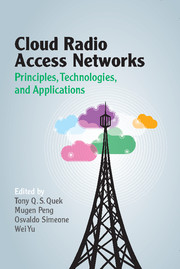Book contents
- Frontmatter
- Contents
- Acknowledgments
- Foreword
- Preface
- List of Contributors
- Part I Architecture of C-RANs
- Part II Physical-Layer Design in C-RANs
- Part III Resource Allocation and Networking in C-RANs
- Part IV Networking in C-RANs
- 16 Mobility Management for C-RANs
- 17 Caching in C-RAN
- 18 A Cloud Service Model and Architecture for Small-Cell RANs
- 19 Field Trials and Testbed Design for C-RAN
- Index
- References
17 - Caching in C-RAN
from Part IV - Networking in C-RANs
Published online by Cambridge University Press: 23 February 2017
- Frontmatter
- Contents
- Acknowledgments
- Foreword
- Preface
- List of Contributors
- Part I Architecture of C-RANs
- Part II Physical-Layer Design in C-RANs
- Part III Resource Allocation and Networking in C-RANs
- Part IV Networking in C-RANs
- 16 Mobility Management for C-RANs
- 17 Caching in C-RAN
- 18 A Cloud Service Model and Architecture for Small-Cell RANs
- 19 Field Trials and Testbed Design for C-RAN
- Index
- References
Summary
Introduction
Mobile traffic has shown an exponential growth during the past decade and is expected to increase by five times in the upcoming five years [1]. This growth is mainly driven by the proliferation of smart devices such as smartphones, mobile tablets, and cameras, coupled with the rising popularity of social networks. Most of the generated traffic is for mobile videos; this is envisioned to represent 80% to 90% of the total generated traffic by 2019 [1, 2]. To support this rapidly growing traffic and meet the strict quality of serivce (QoS) requirements of video streaming users, wireless networks have evolved into a distributed heterogeneous architecture [3]. This structure ismet by a dense deployment of low-power and low-coverage small base stations (SBSs), which offload the traffic from the conventional macro base stations [4]. The use of dense small base stations allows boosting of the network capacity by reducing the distance between the SBSs and the end-user. Moreover, it gives the possibility of sharing the spectrum more efficiently by an improved spectrum-reuse ratio across multiple cells, ensuring higher transmission rates for the users. However, as the network becomes denser, inter-cell and intra-cell interference become more important and cause the overall system performance to deteriorate [5]. Different approaches have been proposed to alleviate this mutual interference, especially leveraging the cooperation between base stations (BSs) through coordinated multi-point (CoMP) transmission techniques [6, 7]. In CoMP, the base stations exchange information about channel state and cooperate to form a group that serve a given user. Even though this approach can significantly improve the spectral efficiency and increase the system throughput, its performance depends on the number of base stations in the network as well as the capacity of the backhaul links. In fact, cooperation between the distributed base stations requires an important amount of signaling and exchange of control information between the BSs, which limits the performance of CoMP in capacity-limited backhaul networks [6].
Recently, a centralized (or cloud) network architecture known as C-RAN [8] was introduced as an energy-efficient and low-cost paradigm with high-processing capabilities. In C-RAN the cooperation between the BSs can be implemented in a centralized and efficient way.
Information
- Type
- Chapter
- Information
- Cloud Radio Access NetworksPrinciples, Technologies, and Applications, pp. 407 - 430Publisher: Cambridge University PressPrint publication year: 2017
